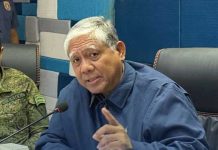
THE STILL-RESTIVE Mount Kanlaon on Negros Island once again made its presence felt on April 8, erupting and sending plumes of volcanic ash into the air. The sudden rumble triggered panic among nearby communities.
This marks the fourth eruption of Kanlaon since June 3, 2024. According to the Philippine Institute of Volcanology and Seismology (Phivolcs), all four recent eruptions—on June 3 and December 9, 2024, and March 6 and April 8, 2025 — were phreatic in nature. These are different from the more violent magmatic eruptions, like the one in 1902.
Still, Phivolcs and Task Force Kanlaon are keeping a close watch, projecting the possibility of a “Big One” — a major eruption that could happen at any time.
But residents of La Castellana continue to pray that a catastrophic eruption like the one on October 10, 1969 — which forced nearly the entire town to evacuate to Himamaylan City — won’t happen again.
***
Everyone Is Tired
Behind the latest rumble on April 8 is a deeper, quieter story — one of fatigue among stakeholders now grappling with a four-month-long Kanlaon crisis. These stakeholders include local officials, donors, and, most of all, the evacuees.
As of this writing, La Castellana and La Carlota continue to shelter more than 5,000 evacuees in 12 evacuation centers, following the December 9 eruption.
With candor, Negros Occidental 5th District’s Cong. Dino Yulo told me, “Everyone is tired now.”
“Everyone involved in this dragging Kanlaon crisis is physically, mentally, and emotionally drained. There’s mental anguish — and even donor fatigue,” Yulo stressed.
He expressed deep concern for the 4,237 evacuees from 1,360 families in five villages of La Castellana — Biak Na Bato, Cabagnaan, Mansalanao, Masulog, and Sag-ang — all within his district.
Permanent Relocation Site
Yulo is now calling on the national government to step in. He said a permanent relocation site must be identified for the thousands of evacuees.
“I believe the government should tap the Department of Agrarian Reform (DAR) to locate CARPable land — large, ideally with agricultural potential — that could serve as a permanent relocation site for Kanlaon evacuees,” Yulo said.
If not, and if this crisis continues for another month or more, Yulo warned that the situation in the evacuation centers could worsen. The evacuees’ mental anguish, like the volcano, could erupt — triggering chaos that would be difficult to contain.
He also emphasized that relocation efforts would be futile without a farming component. Evacuees, most of whom are farmers, cannot thrive in a so-called “tent city” like the one in Himamaylan. It only adds discomfort and frustration.
Starved of Sexual Needs
Here’s a peculiar but very real issue — the deprivation of physiological, particularly sexual, needs.
According to John de Asis, head of La Castellana’s Municipal Disaster Risk Reduction and Management Office, many evacuee-husbands have become irritable due to the lack of intimacy, often leading to quarrels with their spouses.
While it may sound amusing, this issue is not to be dismissed — it adds another layer of complexity to an already fragile situation.
Even Cong. Yulo acknowledged this as an “urgent matter” that must be addressed as soon as possible.
‘Rescue Us Now’
La Castellana’s Mayor Alme Rhummyla Nicor-Mangilimutan is making a heartfelt appeal to Malacañang: “Please, rescue us now.”
She revealed that their local funds are nearly exhausted due to the ongoing Kanlaon crisis. As of April 12, the P50-million aid from Malacañang — channeled through the provincial government to cover evacuees’ meals — will run out.
After that, the local government of La Castellana will once again bear the cost of feeding the evacuees — about P500,000 per day.
“We don’t have enough money anymore. As in!” exclaimed Mayor Mangilimutan.
Raul Fernandez, head of Task Force Kanlaon, said an additional P80-million quick response fund (QRF) for the Office of Civil Defense has been approved. It will be divided among La Castellana, La Carlota, and Canlaon City in Negros Oriental.
But the lingering question remains: When will the funds be released?
***
‘When Will This End?’
Flora Mae Baricuatro, 39, a mother from Mansalanao, is growing weary.
“San-o pa ni matapos?” she asked in our interview.
She and her family, including three children, have been living at St. Vincent’s School in La Castellana for four months now. Their home lies within the six-kilometer danger zone — declared a no man’s land by Task Force Kanlaon.
Food is not an issue, she said. But they want to go home, resume normal life, and rebuild.
Waiting in Vain
Task Force Kanlaon’s Fernandez acknowledges the growing problems of evacuees. He sympathizes with their exhaustion — but said their duty remains: to ensure safety amid the volcano’s unpredictable behavior.
His sentiment is valid. No one wished for this crisis. No one wants to suffer this long. As Cong. Yulo put it, evacuees are now in a “waiting in vain” state.
No one knows when Mount Kanlaon will settle. But in these incredibly trying times, perhaps we can find strength in the words of 2018 Nobel Laureate in Economics Paul Romer:
“A crisis is a terrible thing to waste — because even it highlights the potential for growth and transformation that can emerge from difficult times.”
Let’s hope so. /PN







